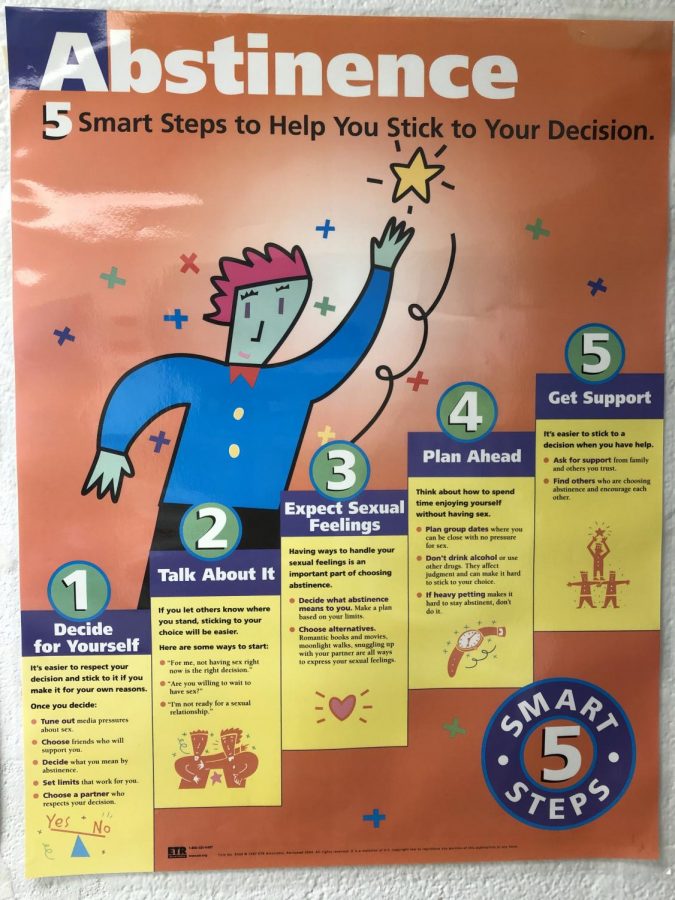How you can prevent the spread of STDs
The school clinic is a good resource for finding out more information in regards to STDs. Above is a poster from the clinic about abstinence.
A sexually transmitted disease, commonly known as an STD, is an infection that can spread during any type of sexual contact with another person. Anyone who is sexually active can get an STD.
Unfortunately, Americans ages 15-24 make up about 50% of all STD cases. Those statistics are more than enough to get parents and schools worried.
However, thanks to the talks we get from parents at home, what we learn in health class, and the posters that hang in most doctor’s offices and clinics, most teens know that there are ways to prevent the contraction of STDs.
Here are some methods of prevention that sexually active teens can use:
1) Condoms
This is undoubtedly the most used method. It is also the only form of birth control that also protects against STDs. This means that they also provide protection against pregnancy, which is one reason why they are an ideal option.
When condoms are used consistently and correctly, they are effective 98% of the time. Since so many people use them incorrectly, the total effectiveness is actually closer to 85%. They can easily be bought at drug stores for cheap prices. Some dorms at colleges even hand them out for free.
2) Vaccination
This method is safe and effective, but it’s abilities are limited. Vaccinations only provide protection against two STDs: hepatitis B and the human papillary infection, also known as HPV.
It’s best to get all the shots before becoming sexually active, but it’s perfectly fine to get them after, too. These vaccinations include three rounds and are recommended to all girls up to age 26 and all boys up to age 21.
3) Having few partners
It’s okay to have multiple partners, and this method doesn’t guarantee that you will never get a sexually transmitted disease. Still, ,statistics show that if you reduce the number of sexual partners you have, then the chances of getting a sexually transmitted disease will reduce as well.
4) Mutual Monogamy
Mutual monogamy means that you have agreed to be sexually active with just one person, and that person has agreed to only be sexually active with you. Being in a committed relationship with a partner that you know to be uninfected is definitely one of the safest ways to prevent getting an STD.
5) Frequent Testing
Before you take all these steps, it’s important to know if you have already contracted an STD. You should get tested every time you have sexual contact with a new person.
You should also get tested if you have sexual relations with an old partner after a long time, and/or if your partner has been sexually active with someone else. Getting tested often is also a good idea because then if you do have an STD, you’ll be able to catch it early.
6) Open Communication
It’s also important that you and any partners have honest conversations when it comes to STDs. You should let your partner know if you have an STD before having sex with them, and they should do the same. It’s best to not have sex with someone who refuses to tell you about their status.
7) Practice Abstinence
This is the only 100% way to avoid STDs. Abstinence is the choice of simply not having any type of sexual encounter. Many people practice abstinence for religious reasons. It’s okay to start practicing abstinence after you have already had a sexual experience. Although it can be difficult, it’s worth considering.

Junior Mia Antezana grew up in Cochabamba, Bolivia. She attended a music school called Instituto Eduardo Laredo before moving to the U.S. She now plays...












Dr. Narayan Roy • Oct 27, 2018 at 12:39 am
The main and important step according to me to avoid STD is to have a proper precaution and of course share the problem before your partner so that you can keep her/him safe. Condoms give you that precaution, though doctors not completely rely on condoms. but it is true that to a large extent condoms reduces the possibility of getting infected.